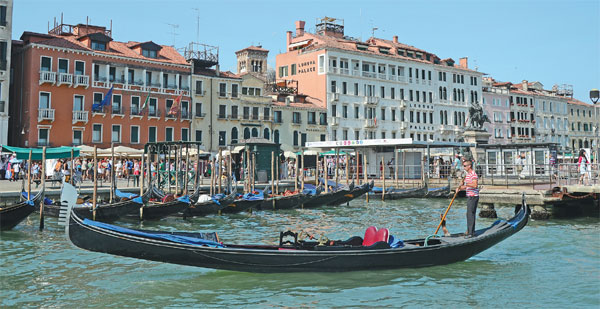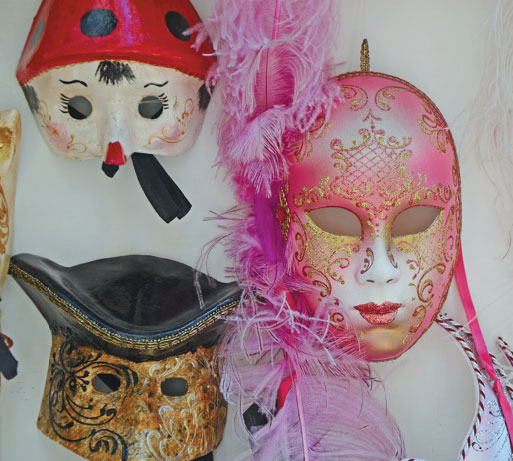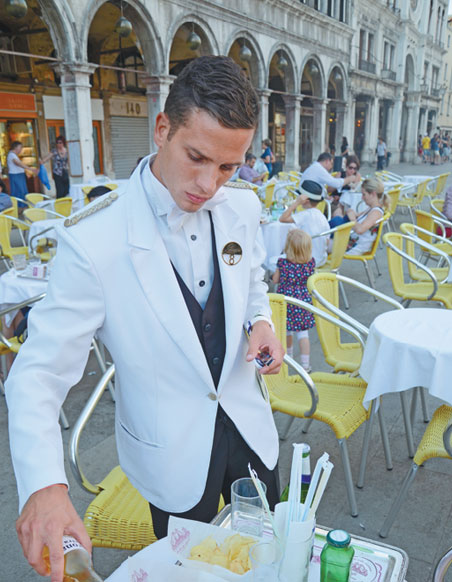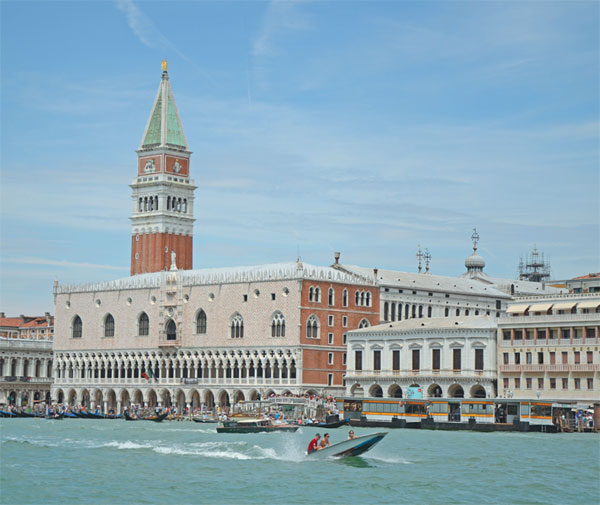Sensory overload
Updated: 2014-03-23 08:10
By Mark Graham(China Daily)
|
|||||||
|
A gondolier plies for trade along the Venice lagoon waterfront. Some of the striped-shirt operators even provide operatic accompaniments for their passengers. Photos by Mark Graham / For China Daily |
|
The imposing church of Santa Maria della Salute marks the entrance to the Grand Canal. It was built in 1687. |
|
Delicately wrought masks, a Venetian specialty, make great, and inexpensive, souvenirs. |
|
A slickly dressed waiter pours a drink in St. Mark's Square. |
|
The top of the campanile, or bell tower, of St. Mark's Square offers sensational views of the city. |
Venice is a feast for the faculties - especially on a sunny day. Mark Graham discovers.
Arrive in Venice on a rainy day and the much-touted canals and houses are cast in a muted, enigmatic light. Turn up when the sun is shining and the sensory blitz is almost too much to behold - a heady cultural concoction of singing gondoliers, vivid pink mansions and tantalizing cooking smells.
Rain or shine, people arriving by rail are invariably astonished by the instant impact of the city. The train clanks its way across a long causeway, allowing fabulous window glimpses of the city beyond, before hitting the end-of-the-line buffers. At first blush, Venice station is just like any other urban terminal: bustling with touts, a little on the scruffy side, seriously lacking character.
But on the steps outside, within a few meters of leaving the jangling chaos of the forecourt, the famed city displays itself at full-on strength. Arrayed immediately beyond the station steps is the Venice of legend and imagination, with its chaotic canals, striped-shirt gondoliers and refined waterside houses.
The impact of that first glimpse of the Adriatic seaport cannot be surpassed, but it is matched, time and time again, during a short stay in the rightly renowned city of romance. Granted some elements are hokey and commercialized - gondolier rides are a particularly pricey way of getting around - but in essence the city has stayed the same for the best part of two or three centuries.
Compare a Canaletto canvas painted during the mid-18th century with the view of today and there will only be a few changed elements; examine centuries-old paintings, created during the Renaissance era and before, and the major churches and landmarks will be recognizably the same, the view unblemished by contemporary architectural experiments.
And all these marvelous city highlights are within easy strolling distance. Nowhere is far away in Venice, a place that can be traversed entirely by foot in an hour or so, always assuming the walker does not become hopelessly lost in the lookalike alleys and streets that snake around and over the subsidiary canals.
But surprise discoveries invariably come from aimless ambling, relying on street-sign pointers for general directions: Almost every pedestrian junction has an arrow pointing toward St. Mark's Square, at the bottom of the city proper, or Rialto Bridge, near the top.
Both landmarks live up to the advance billing. St. Mark's Square in particular, backing onto the Basilica and Doge's Palace, justifies the praise conquering emperor Napoleon heaped on it, deeming it the best drawing room in the whole of Europe.
Over the centuries, other famous people have agreed with the diminutive French general's view. Novelist Charles Dickens came to Venice to take the air and admire the views; poet Robert Browning spent long months pottering around; the artist Canaletto went in the other direction, to London, where some of his 18th-century Venetian works hang in the National Gallery.
Louche barflies such as the sparse-style American writer Ernest Hemingway ventured to Venice to drink a lot and carouse. Favored hangouts were the genteel coffee shops of the square, where bands still strike up jaunty classical tunes every afternoon, and the waterside Harry's Bar, famed for its bellini cocktails, steep prices and close-together tables.
Such is the worldwide fame and magnetic lure of St. Mark's Square that even on a gray autumn day the square is full. The bold chatter from tourists is drowned out hourly by earshattering peals from cast-iron bells far above.
The square's bell-tower fell to pieces at one point, crumbling into a sad heap after long centuries of service. It was carefully rebuilt and - to the outrage of the purists - a lift installed, saving the infirm, disabled or merely lazy a tough pant to the top.
From the ramparts, the often-baffling street-level geography of Venice begins to make some sense. On a clear day, the entire lagoon and its criss-crossing patchwork of major and minor canals are on view.
One particular canal crossing, the Bridge of Sighs, is endlessly photographed. Convicted prisoners were led in chains across the bridge to the city jail and, understandably, let out long sighs of anguish at the prospect of years in a fetid cell, or an imminent date with the executioner's block. The most famous escapee from within these stone walls was a nobleman well versed in the art of subterfuge and trickery - the famous lothario Casanova.
Intrigue aside, it was canny merchant trading that brought vast wealth to Venice, enough to fund a well-equipped navy that could be used to repel would-be invaders or embark on expansionist expeditions in nearby Adriatic waters.
The only contemporary aggression comes from gondolier touts, flogging their hour-long punts around the canals for amounts akin to a weekly wage in many jurisdictions.
The starting price for a quick gondola ride is around $100, much more if a singer and accordionist come aboard to drum up a few romantic melodies. To pop aficionados unschooled in the subtleties of Italian arias, all the tunes seem to sound remarkably like variations of the Elvis Presley hit It's Now Or Never.
Dodgy crooning notwithstanding, there is something incomparably romantic about being propelled slowly through the narrow canals, past the crumbling houses and under the narrow arches of bridges. Nighttime expeditions through the canals come with an extra frisson of mystery ... spooky dark corners, flickering street-lamps, oddly shaped shadows and the eerie splish-splash of the boatman's oar hitting the water.
A cheaper, more practical and - let's be frank - less refined way of exploring the nautical nooks and crannies of this glorious city is by ferry.
The utilitarian, chug-chugging boats are given an extra aura of glamour and pizzazz by the ticket-collectors and captains. Younger male Venetians appear to have been born with a pair of wraparound shades attached to their (usually shaven) skulls and a dash of irreverent showmanship in their genes.
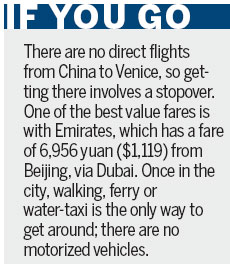
The very act of helping an old woman off the rocking ferry becomes an act of pure theater, all gesticulation and excited chatter, the showbiz affectations perhaps inspired by the many movies made in Venice, from the not-long-ago The Talented Mr Ripley with heartthrob Matt Damon back to Death in Venice with matinee idol Dirk Bogarde.
Almost all films have used the extravagant backdrop to great effect, the camera panning along the grand canal houses and zooming in lovingly on the exquisitely ornate architecture of its churches and cathedrals.
All this cultural overload comes at a price. By no stretch of the imagination is Venice a bargain. Never has been, never will be. Nonetheless, few people catch the departing train or plane griping about the damage inflicted on their credit cards. The talk is of saving enough to come back. Soon.
Even in the rain, which is so plentiful during certain times of the year that duck-boards are piled up, ready to be used, it has a warm charm. After experiencing the place in the dark and drizzle, a burst of sunshine zinging through is all the more welcome, transforming Venice from merely magnificent to simply divine.
Contact the writer at sundayed@chinadaily.com.cn.
(China Daily 03/23/2014 page10)
